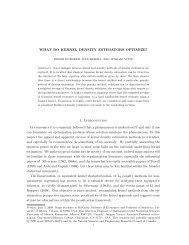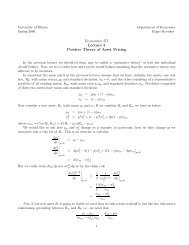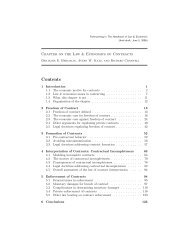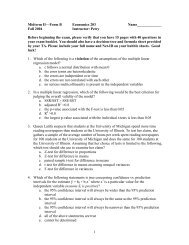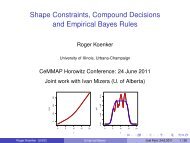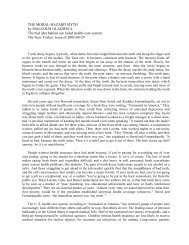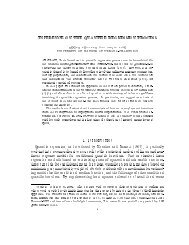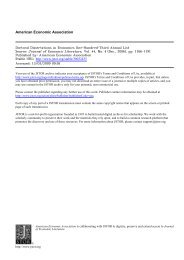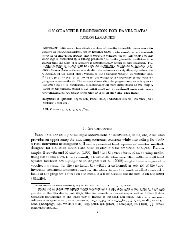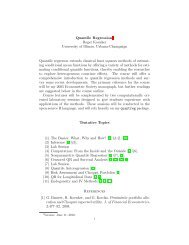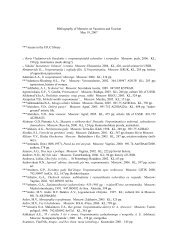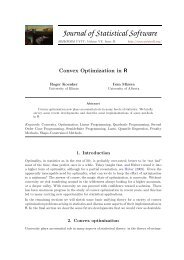Cross-Asset Speculation in Stock Markets∗ - Econometrics at Illinois ...
Cross-Asset Speculation in Stock Markets∗ - Econometrics at Illinois ...
Cross-Asset Speculation in Stock Markets∗ - Econometrics at Illinois ...
Create successful ePaper yourself
Turn your PDF publications into a flip-book with our unique Google optimized e-Paper software.
of the less vol<strong>at</strong>ile asset’s value. In sum, the division of <strong>in</strong>form<strong>at</strong>ion between assets m<strong>at</strong>ters <strong>in</strong>complic<strong>at</strong>ed ways for trad<strong>in</strong>g str<strong>at</strong>egies, but not aggreg<strong>at</strong>e outcomes.[Figure 8 about here]IV ConclusionThis paper develops a method to solve for str<strong>at</strong>egic specul<strong>at</strong>ive outcomes <strong>in</strong> a multi-asset stockmarket when specul<strong>at</strong>ors see prices and <strong>in</strong>ternalize how their trades affect the <strong>in</strong>form<strong>at</strong>ional contentof prices. We thereby build on Adm<strong>at</strong>i’s (1985) noisy r<strong>at</strong>ional expect<strong>at</strong>ions model to allow forstr<strong>at</strong>egic behavior by specul<strong>at</strong>ors. In particular, specul<strong>at</strong>ors <strong>in</strong> our model <strong>in</strong>ternalize the fact th<strong>at</strong>they are <strong>in</strong>form<strong>at</strong>ionally large and th<strong>at</strong> their trades have impacts on prices th<strong>at</strong> convey <strong>in</strong>form<strong>at</strong>ionto other specul<strong>at</strong>ors. Because asset values are correl<strong>at</strong>ed, a signal about one asset conta<strong>in</strong>s <strong>in</strong>form<strong>at</strong>ionabout other assets, and because there are multiple specul<strong>at</strong>ors, each specul<strong>at</strong>or uses the<strong>in</strong>form<strong>at</strong>ion <strong>in</strong> prices to try to unravel the signals of others. We prove th<strong>at</strong> there is a unique l<strong>in</strong>earequilibrium by develop<strong>in</strong>g an iter<strong>at</strong>ive best-response mapp<strong>in</strong>g and show<strong>in</strong>g th<strong>at</strong> it is a contraction.We then offer several testable predictions. We gener<strong>at</strong>e predictions about the covariance structuresof prices changes (returns) and order flows across stocks th<strong>at</strong> are driven solely by str<strong>at</strong>egicbehavior. In particular, we f<strong>in</strong>d th<strong>at</strong> the covariance structure of prices is driven by the covariancestructure of asset fundamentals, while the covariance structure of order flows is driven by the covariancestructure of liquidity trade. We also show th<strong>at</strong> <strong>in</strong> <strong>in</strong>tegr<strong>at</strong>ed markets, the use of cross-asset <strong>in</strong>form<strong>at</strong>ionby market makers causes prices to be more correl<strong>at</strong>ed than the underly<strong>in</strong>g fundamentals,and th<strong>at</strong> this, <strong>in</strong> turn, raises the vol<strong>at</strong>ility of prices. F<strong>in</strong>ally, we provide theoretical underp<strong>in</strong>n<strong>in</strong>gsfor the Hasbrouck and Seppi (2001) f<strong>in</strong>d<strong>in</strong>g th<strong>at</strong> commonality <strong>in</strong> order flows expla<strong>in</strong>s two-thirds ofthe commonality <strong>in</strong> returns, gener<strong>at</strong><strong>in</strong>g this <strong>in</strong> our model with a moder<strong>at</strong>e cross-asset correl<strong>at</strong>ion<strong>in</strong> asset value fundamentals plus a slight positive correl<strong>at</strong>ion <strong>in</strong> liquidity trade across assets.While one must be careful transl<strong>at</strong><strong>in</strong>g predictions from a stylized model to the real world, thequalit<strong>at</strong>ive implic<strong>at</strong>ions are clear. The transparency of pric<strong>in</strong>g and order flows across assets hasgre<strong>at</strong>ly <strong>in</strong>creased <strong>in</strong> recent years. This suggests th<strong>at</strong> the market has become “closer” to our observableprice sett<strong>in</strong>g. Accord<strong>in</strong>gly, (a) the vol<strong>at</strong>ility of returns and net order flows should have27



